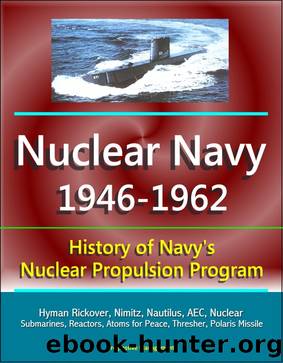Nuclear Navy 1946-1962 by Progressive Management

Author:Progressive Management
Language: eng
Format: epub
Tags: nuclear, nuclear submarine, atomic, eisenhower, reactor, rickover, nimitz, nuclear propulsion
Publisher: Progressive Management
Building the Nuclear Fleet: Horizontal Extension of the Navy Project
The development and manufacture of nuclear propulsion plants for the fleet were activities closely allied to the Commission's responsibilities. Nuclear reactors, even in the late 1950s, were still largely the Commission's domain. As described in chapter 9, Rickover used this distinction to keep reactor and core manufacturing out of the Navy's procurement system. In this sense he had extended his original project organization vertically to include not only the development of nuclear propulsion systems but also the procurement of materials, the fabrication of components, and the virtual mass production of propulsion plants.
When it came to building the submarines and ships in which these reactors were to be installed, however, Rickover could neither hope nor wish to create a separate organization independent of the Navy. Ship design and construction involved a wide spectrum of specialized skills and techniques which Rickover's organization could master with little advantage. At the same time Rickover considered it imperative to maintain control over the design and construction of those parts of nuclear ships which contained the reactor and the propulsion machinery. In his opinion nuclear propulsion was not yet a conventional technology which the established codes in the Bureau of Ships could handle in a routine manner. The only hope for creating a fleet of nuclear ships seemed to lie in maintaining the same standards and discipline which Rickover and his associates had established in building the Nautilus.
During the development and construction of the Nautilus, Rickover had relatively clear responsibilities. He had full control over the design and development of the propulsion system. He had some influence on the design of the submarine, particularly on those features related to the propulsion system. He imposed his own standards on propulsion equipment and had full control over tests and sea trials of the propulsion plant. The senior officers and engineering department of the ship were selected and trained according to his standards. But the Bureau of Ships, operating through various codes, had general responsibility for the completion of the ship.
As the prospects of large numbers of nuclear ships began to emerge in 1955, there was some uncertainty in the Bureau of Ships about what Rickover's role would be. Admiral Mumma, who believed Rickover had passed the point of his greatest usefulness to the Navy, had no desire to help Rickover extend his influence beyond Code 1500 to other parts of the bureau. Rickover, for his part, was just as determined to exercise his responsibilities as a Commission official to see that the Navy's nuclear propulsion plants were properly constructed and operated.
Rickover would have to find ways of asserting the controls he thought necessary through established channels in the Navy. This he could accomplish, not so much by extracting formal delegations of authority from the chief of the bureau, but by attempting to apply his influence in less formal but equally effective ways. A strong challenge to this effort was the Polaris program in which Admiral Burke, as Chief of
Download
This site does not store any files on its server. We only index and link to content provided by other sites. Please contact the content providers to delete copyright contents if any and email us, we'll remove relevant links or contents immediately.
| Africa | Americas |
| Arctic & Antarctica | Asia |
| Australia & Oceania | Europe |
| Middle East | Russia |
| United States | World |
| Ancient Civilizations | Military |
| Historical Study & Educational Resources |
Machine Learning at Scale with H2O by Gregory Keys | David Whiting(4179)
Never by Ken Follett(3790)
Fairy Tale by Stephen King(3220)
The Man Who Died Twice by Richard Osman(2997)
Oathbringer (The Stormlight Archive, Book 3) by Brandon Sanderson(2877)
Will by Will Smith(2792)
Rationality by Steven Pinker(2291)
The Dark Hours by Michael Connelly(2243)
Can't Hurt Me: Master Your Mind and Defy the Odds - Clean Edition by David Goggins(2227)
The Dawn of Everything: A New History of Humanity by David Graeber & David Wengrow(2122)
Friends, Lovers, and the Big Terrible Thing by Matthew Perry(2119)
Principles for Dealing With the Changing World Order: Why Nations Succeed and Fail by Ray Dalio(1974)
HBR's 10 Must Reads 2022 by Harvard Business Review(1776)
A Short History of War by Jeremy Black(1762)
Go Tell the Bees That I Am Gone by Diana Gabaldon(1687)
515945210 by Unknown(1599)
A Game of Thrones (The Illustrated Edition) by George R. R. Martin(1589)
Kingdom of Ash by Maas Sarah J(1524)
443319537 by Unknown(1470)
